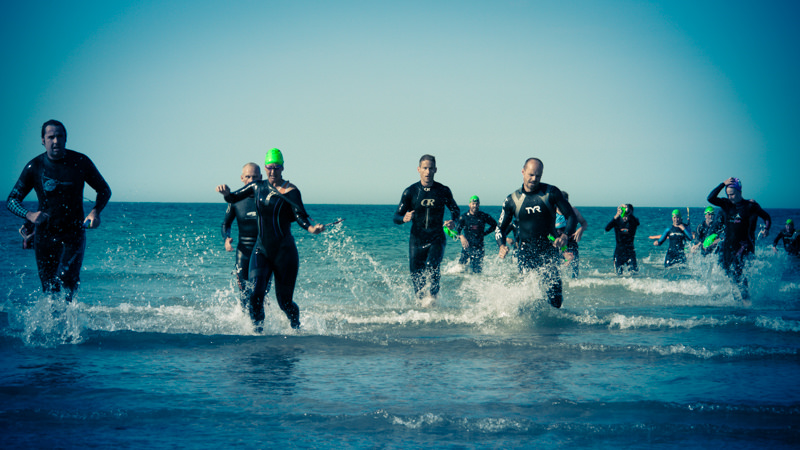The main goal of race day nutrition is to keep sodium and blood sugar levels sufficient for optimum energy output while avoiding indigestion or bloating. Swimming, biking and running put stress on the body, which makes it more difficult to process calories. Triathletes have to strike the balance between making themselves sick and running out of energy. Both make for a very painful race.
The Race Day Breakfast
The first thing to consider is the race day breakfast. The optimal time to eat breakfast is three hours before race time. This might mean waking up, eating, and going back to sleep, but it will be worth it. There will need to be plenty of time to digest the food, and not be competing on an empty stomach.
Although it depends on preference, whole grains, fruits, and a sports drink typically work quite well nutritionally. The key thing is to eat something that is easy on the stomach.
Pre-Swim: To Snack or Not to Snack?
Nutrition is an option on the swim leg. Many athletes feel the need to drink a sports drink or eat a small snack up to an hour before the start of the race. This will not make or break your day. So it is fine to have a quick snack or a drink shortly before the start of the race.
The race day breakfast and pre-race snack are universally applicable for any triathlon distance. The nutrition plan detailed below is designed with an Olympic or longer distance in mind. However, it is mostly based on time, so following the basic requirements of this plan will work for any distance.
The Bike
The most important leg of the race for nutrition is the bike. This will be the fuel needed for the bike, which is what many consider the toughest leg of the race. Depending on how long it takes to a triathlete to get through the bike portion of the race, temperatures may start to rise. When it becomes warmer, sodium starts to seep out of the body faster, and cramps are just around the corner.
The bike leg provides the perfect time to stock up on sodium and ensure a strong finish. It is easier to process food on the bike since your stomach is not being jostled around as much as it will be on the run. Most people can consume between 250 and 300 calories. This can be accomplished through a variety of strategies.
A simple method includes carrying two bottles; one with your sports drink of choice and the other filled with water. Also, carry an energy bar, a gel packet, or both. Athletes who are heavy sweaters, or if it is an extra hot day, add electrolyte tablets with high sodium content to the water bottle.
Keep in mind that storage can become an issue, especially in longer distances. Consider wearing a jersey to take more food. Some athletes have been creative and taped it to the frame of their bike.
There are several ways to consume those 250 – 300 calories. Each triathlete must find the combination that works best for them. Below is a sample of what a two-hour bike leg might look like when it comes to calorie consumption. If it takes longer than two hours to finish the bike leg, adapt this plan accordingly.
Pro tip: It is possible to eat or drink during the transition to the bike, but it would serve the athlete to allow their stomach to settle after the swim. If the athlete consumes food or drink, other than water they must count it towards their first hour of calories.
The sports drink in the example has 80 calories per 12 ounce serving. The energy bar has 230 calories and the gel pack has 90.
Time on Bike Action Taken Calories
15 min. 6 oz. sports drink + ½ bar = 155 calories
30 min. 6 oz. drink = 40 calories
45 min. 6 oz. sports drink = 40 calories
1 hr. 6 oz. drink + gel pack = 285
1hr 15 min 6 oz. drink = 40 calories
1hr 30 min 6 oz. sports drink+ ½ bar = 155 calories
1hr 45 min 6 oz. sports drink = 40 calories
2 hr 6 oz. drink + gel = 285 calories
The Run
On the run, most people can ingest 200 – 250 calories per hour. This number is pretty easy to hit with a combination of a sports drink and gels. A gel is generally preferred to an energy bar on the run because most people find it more palatable. Again, it comes down to preference.
Pro Tip: Drinking water or sports drinks in little sips makes it more difficult for the stomach to process whatever is put in it. Drink 6 oz. (or ¼ of a 24 oz. bottle) at 15 minute intervals.
Hopefully, race day nutrition has been considered and planned far in advance. It is important to practice this nutritional system before the day of the race.
Everyone is different and the amount one consumes nutritionally might be more than another person can handle. Find out what works best by trying different products and flavors. Also, estimate how long each leg will take and plan accordingly. There is no one size fits all, but if the triathlete hits these numbers they should be good to go.
By Chris Meyer
Sources:
Endurance Doc: Race Day Nutrition
Personal Experience
Image Courtesy of Photasia’s Flickr Page – Creative Commons License

